c-Cbl tyrosine kinase-binding domain mutant G306E abolishes the interaction of c-Cbl with CD38 and fails to promote retinoic acid-induced cell differentiation and G0 arrest
- PMID: 19635790
- PMCID: PMC2757968
- DOI: 10.1074/jbc.M109.014241
c-Cbl tyrosine kinase-binding domain mutant G306E abolishes the interaction of c-Cbl with CD38 and fails to promote retinoic acid-induced cell differentiation and G0 arrest
Abstract
Retinoic acid (RA) causes HL-60 human myeloblastic leukemia cell myeloid differentiation that is dependent on MAPK signaling. The process is propelled by c-Cbl, which binds the CD38 receptor as part of a signaling complex generating MAPK signaling. Here we report that the capability of c-Cbl to do this is lost in the G306E tyrosine kinase-binding domain mutant. Unlike wild-type (WT) c-Cbl, the G306E mutant c-Cbl fails to propel RA-induced differentiation, and disrupts the normal association with CD38. The G306E mutant does, like WT c-Cbl, co-immunoprecipitate with Vav, Slp-76, and p38. But unlike WT c-Cbl, does not cause MAPK signaling. In contrast, the C381A Ring finger domain mutant functions like WT c-Cbl. It binds CD38 and is part of the same apparent c-Cbl/Slp-76/Vav/p38 signaling complex. The C381A mutant causes MAPK signaling and propels RA-induced differentiation. In addition to HL-60 cells and their WT or mutant c-Cbl stable transfectants, the c-Cbl/Vav/Slp-76 complex is also found in NB4 cells where c-Cbl was previously also found to bind CD38. The data are consistent with a model in which the G306E mutant c-Cbl forms a signaling complex that includes Slp-76, Vav, and p38; but does not drive MAPK signaling because it fails to bind the CD38 receptor. Without the G306E mutation the c-Cbl unites CD38 with the signaling complex and delivers a MAPK signal that drives RA-induced differentiation. The results demonstrate the importance of the Gly306 residue in the ability of c-Cbl to propel RA-induced differentiation.
Figures
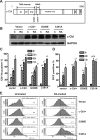

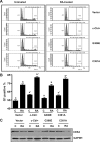
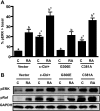
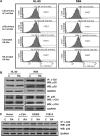
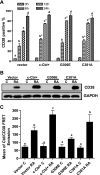
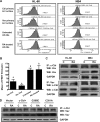
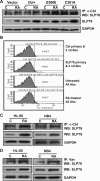
Similar articles
-
Phosphorylation of c-Cbl and p85 PI3K driven by all-trans retinoic acid and CD38 depends on Lyn kinase activity.Cell Signal. 2014 Jul;26(7):1589-97. doi: 10.1016/j.cellsig.2014.03.021. Epub 2014 Mar 29. Cell Signal. 2014. PMID: 24686085 Free PMC article.
-
c-Cbl interacts with CD38 and promotes retinoic acid-induced differentiation and G0 arrest of human myeloblastic leukemia cells.Cancer Res. 2008 Nov 1;68(21):8761-9. doi: 10.1158/0008-5472.CAN-08-1058. Cancer Res. 2008. PMID: 18974118 Free PMC article.
-
Interferon regulatory factor-1 binds c-Cbl, enhances mitogen activated protein kinase signaling and promotes retinoic acid-induced differentiation of HL-60 human myelo-monoblastic leukemia cells.Leuk Lymphoma. 2011 Dec;52(12):2372-9. doi: 10.3109/10428194.2011.603449. Epub 2011 Aug 24. Leuk Lymphoma. 2011. PMID: 21740303 Free PMC article.
-
The Cbl family proteins: ring leaders in regulation of cell signaling.J Cell Physiol. 2006 Oct;209(1):21-43. doi: 10.1002/jcp.20694. J Cell Physiol. 2006. PMID: 16741904 Review.
-
Deregulated intracellular signaling by mutated c-CBL in myeloid neoplasms.Clin Cancer Res. 2010 Aug 1;16(15):3825-31. doi: 10.1158/1078-0432.CCR-09-2341. Epub 2010 Jun 14. Clin Cancer Res. 2010. PMID: 20547695 Review.
Cited by
-
Evidence of off-target effects of bosutinib that promote retinoic acid-induced differentiation of non-APL AML cells.Cell Cycle. 2021 Dec;20(24):2638-2651. doi: 10.1080/15384101.2021.2005275. Epub 2021 Nov 26. Cell Cycle. 2021. PMID: 34836491 Free PMC article.
-
MicroRNA-155 regulates the proliferation, cell cycle, apoptosis and migration of colon cancer cells and targets CBL.Exp Ther Med. 2017 Nov;14(5):4053-4060. doi: 10.3892/etm.2017.5085. Epub 2017 Aug 31. Exp Ther Med. 2017. PMID: 29104623 Free PMC article.
-
An Effective Model of the Retinoic Acid Induced HL-60 Differentiation Program.Sci Rep. 2017 Oct 30;7(1):14327. doi: 10.1038/s41598-017-14523-5. Sci Rep. 2017. PMID: 29085021 Free PMC article.
-
ATRA-induced HL-60 myeloid leukemia cell differentiation depends on the CD38 cytosolic tail needed for membrane localization, but CD38 enzymatic activity is unnecessary.Exp Cell Res. 2011 Apr 15;317(7):910-9. doi: 10.1016/j.yexcr.2010.12.003. Epub 2010 Dec 13. Exp Cell Res. 2011. PMID: 21156171 Free PMC article.
-
6-Formylindolo(3,2-b)Carbazole (FICZ) Modulates the Signalsome Responsible for RA-Induced Differentiation of HL-60 Myeloblastic Leukemia Cells.PLoS One. 2015 Aug 19;10(8):e0135668. doi: 10.1371/journal.pone.0135668. eCollection 2015. PLoS One. 2015. PMID: 26287494 Free PMC article.
References
-
- Yen A., Roberson M. S., Varvayanis S., Lee A. T. (1998) Cancer Res. 58, 3163–3172 - PubMed
-
- Yen A., Roberson M. S., Varvayanis S. (1999) In Vitro Cell Dev. Biol. 35, 527–532 - PubMed
-
- Mann G., Reinhardt D., Ritter J., Hermann J., Schmitt K., Gadner H., Creutzig U. (2001) Ann. Hematol. 80, 417–422 - PubMed
-
- Collins S. J., Gallo R. C., Gallagher R. E. (1977) Nature 270, 347–349 - PubMed
Publication types
MeSH terms
Substances
LinkOut - more resources
Full Text Sources
Research Materials
Miscellaneous

